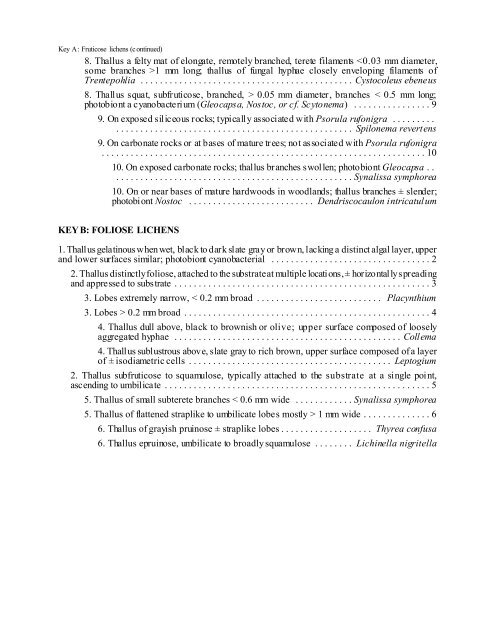lichens of the lower ozark region of missouri and arkansas
lichens of the lower ozark region of missouri and arkansas
lichens of the lower ozark region of missouri and arkansas
You also want an ePaper? Increase the reach of your titles
YUMPU automatically turns print PDFs into web optimized ePapers that Google loves.
Key A : Fruticose <strong>lichens</strong> (c ontinued)<br />
8. Thallus a felty mat <strong>of</strong> elongate, remotely branched, terete filaments 1 mm long; thallus <strong>of</strong> fungal hyphae closely enveloping filaments <strong>of</strong><br />
Trentepohlia ............................................Cystocoleus ebeneus<br />
8. Thallus squat, subfruticose, branched, > 0.05 mm diameter, branches < 0.5 mm long;<br />
photobiont a cyanobacterium (Gleocapsa, Nostoc, or cf. Scytonema) ................9<br />
9. On exposed siliceous rocks; typically associated with Psorula rufonigra .........<br />
................................................. Spilonema revertens<br />
9. On carbonate rocks or at bases <strong>of</strong> mature trees; not associated with Psorula rufonigra<br />
...................................................................10<br />
10. On exposed carbonate rocks; thallus branches swollen; photobiont Gleocapsa ..<br />
.................................................Synalissa symphorea<br />
10. On or near bases <strong>of</strong> mature hardwoods in woodl<strong>and</strong>s; thallus branches ± slender;<br />
photobiont Nostoc .......................... Dendriscocaulon intricatulum<br />
KEY B: FOLIOSE LICHENS<br />
1. Thallus gelatinous when wet, black to dark slate gray or brown, lacking a distinct algal layer, upper<br />
<strong>and</strong> <strong>lower</strong> surfaces similar; photobiont cyanobacterial .................................2<br />
2. Thallus distinctly foliose, attached to <strong>the</strong> substrate at multiple locations, ± horizontally spreading<br />
<strong>and</strong> appressed to substrate .....................................................3<br />
3. Lobes extremely narrow, < 0.2 mm broad .......................... Placynthium<br />
3. Lobes > 0.2 mm broad ...................................................4<br />
4. Thallus dull above, black to brownish or olive; upper surface composed <strong>of</strong> loosely<br />
aggregated hyphae ...............................................Collema<br />
4. Thallus sublustrous above, slate gray to rich brown, upper surface composed <strong>of</strong> a layer<br />
<strong>of</strong> ± isodiametric cells .......................................... Leptogium<br />
2. Thallus subfruticose to squamulose, typically attached to <strong>the</strong> substrate at a single point,<br />
ascending to umbilicate .......................................................5<br />
5. Thallus <strong>of</strong> small subterete branches < 0.6 mm wide ............Synalissa symphorea<br />
5. Thallus <strong>of</strong> flattened straplike to umbilicate lobes mostly > 1 mm wide ..............6<br />
6. Thallus <strong>of</strong> grayish pruinose ± straplike lobes ................... Thyrea confusa<br />
6. Thallus epruinose, umbilicate to broadly squamulose ........ Lichinella nigritella


